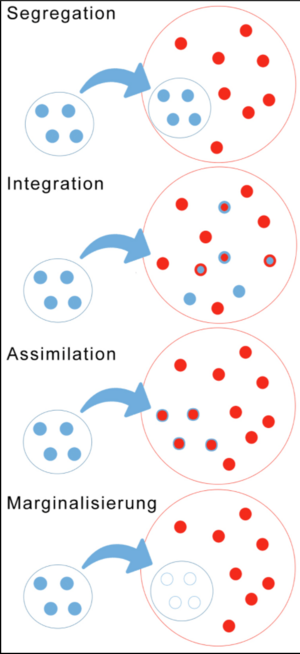Acculturation facts for kids
Acculturation is about what happens when people from different cultures meet and interact. It's how one person or a whole group from one culture connects with another person or group from a different culture. Sometimes, these cultures might be quite similar, or they could be very different.
Unlike culture shock, acculturation looks at how both cultures change and influence each other. Culture shock usually focuses only on the person or group entering a new culture. But with acculturation, we look at how everyone involved is affected. Many things can be shared between the two cultures, like language, ways of living, or even foods. Acculturation is a process that happens over a long time, not just once or twice.
Cultural diffusion is a bit different. Diffusion might happen quickly, and it means there's an equal exchange. With acculturation, the changes might not be equal for both sides.
Contents
What is Acculturation?
Acculturation describes the process where people from different cultures come into contact. This contact leads to changes in one or both cultures. It's a two-way street where ideas, customs, and even languages can be exchanged. This process happens over a long time as groups live near each other or mix.
How We Study Acculturation
The idea of acculturation first came from people who study anthropology. These scientists wanted to learn more about how different cultures interact. They also looked at what happens when people from these cultures meet.
Psychologists also study acculturation. They are interested in how these cultural changes affect individuals. For example, how does a person feel when they move to a new country? Sociologists look at acculturation too. They study how entire societies change when new cultures join them or interact with them.
Different Ways Cultures Mix
When cultures interact, there can be four main outcomes. Think of it like different ways people might blend or stay separate. These four ways are shown in the picture on the right.
- Assimilation is when one culture completely takes on the ways of another. It's like a group losing its original identity and becoming just like the new culture. In the picture, all the blue dots become red dots.
- Integration happens when a culture keeps some of its original ways but also tries to be part of the new culture. They blend old and new. In the picture, some blue dots are still blue, but some are trying to act like red dots.
- Separation is when cultures interact but don't really change each other. They stay distinct and keep their own traditions. In the picture, red and blue dots are together but don't change color.
- Marginalization is when a culture doesn't interact much with another and also loses its own cultural identity. It's like being left out and losing your roots. In the picture, the blue dots are separate and not colored in, while the red dots stay the same.
Acculturation in Social Science
Anthropologists, psychologists, and sociologists all use the idea of acculturation. It helps them explain changes that happen when cultures meet. One way to measure how much acculturation is happening is through something called acculturative stress.
Acculturative stress helps researchers understand what happens to people and groups during this process. Many studies have looked at how acculturative stress affects the health of individuals. Other studies have focused on immigrantpopulations in places like the United States. They also look at other minority groups and how they adapt.
Images for kids
See also
 In Spanish: Aculturación para niños
In Spanish: Aculturación para niños



